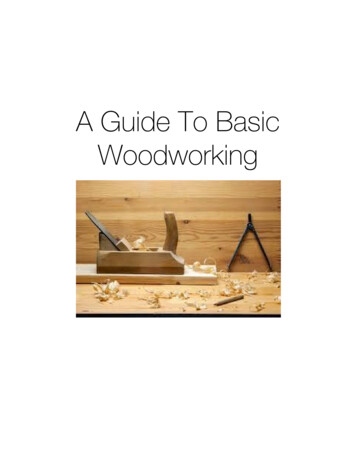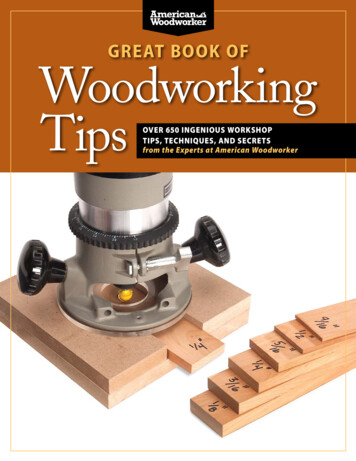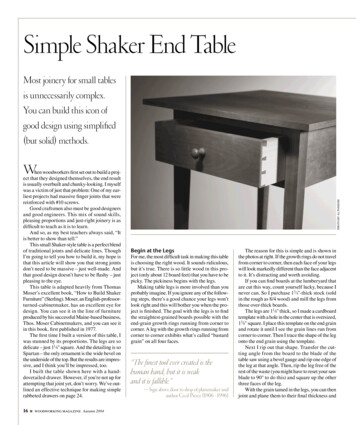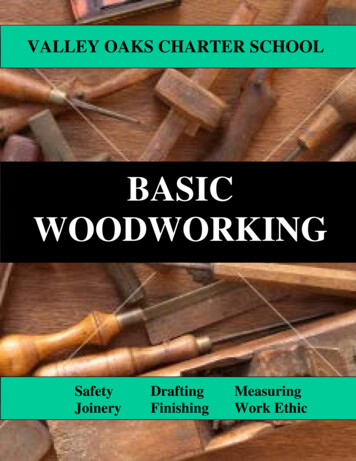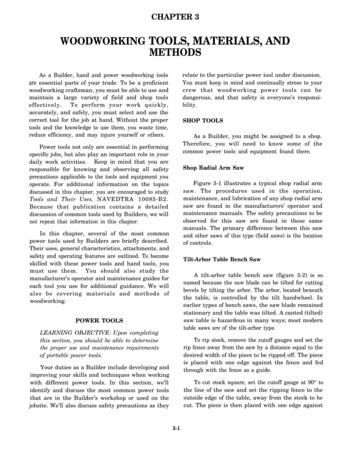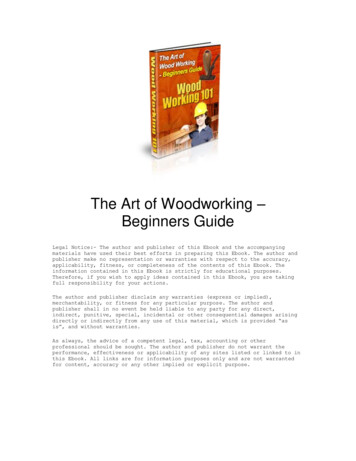
Transcription
The Art of Woodworking –Beginners GuideLegal Notice:- The author and publisher of this Ebook and the accompanyingmaterials have used their best efforts in preparing this Ebook. The author andpublisher make no representation or warranties with respect to the accuracy,applicability, fitness, or completeness of the contents of this Ebook. Theinformation contained in this Ebook is strictly for educational purposes.Therefore, if you wish to apply ideas contained in this Ebook, you are takingfull responsibility for your actions.The author and publisher disclaim any warranties (express or implied),merchantability, or fitness for any particular purpose. The author andpublisher shall in no event be held liable to any party for any direct,indirect, punitive, special, incidental or other consequential damages arisingdirectly or indirectly from any use of this material, which is provided “asis”, and without warranties.As always, the advice of a competent legal, tax, accounting or otherprofessional should be sought. The author and publisher do not warrant theperformance, effectiveness or applicability of any sites listed or linked to inthis Ebook. All links are for information purposes only and are not warrantedfor content, accuracy or any other implied or explicit purpose.
Table of ContentsIntroduction To Woodworking . 3Safety First. 5Hardwoods Vs Softwoods . 8Various Styles Of Saws . 11Measure Twice, Cut Once . 13Chisel Basics . 16Choosing Hand Tools . 18Adhesives For Woodworking . 20Sharpening Tools – Get To The Point. 22Making Joints . 24Deciding What To Build . 27Creating Working Drawings . 29Finishes And Fillers. 312 Page
Introduction To WoodworkingWoodworking encompasses a great number of diverse activities, includingturning, woodcarving, marquetry, cabinetmaking and joinery, however, everyspecialist craftsman or craftswoman has at some time mastered thefundamentals of measuring and marking, dimensioning, assembling and finishing– considered the basics of woodworking skills that are the core of anywoodworking calling.The ability to think in three dimensions is needed to mark out the wood for aproject and to imagine how one component fits with another and in what order isrequired of a woodworker. You will also need to know which tools will give thebest results, depending on the level of accuracy required and the properties ofthe wood you are using.Dimensioning is the process of reducing raw materials accurately to size. Thisalmost invariably entails planning components square and true – a procedurethat is simple in principle but takes a lot of practice to become perfect.Cutting and assembling a variety of joints are part of all but the simplest ofwoodworking projects. Long been regarded as a measure of a woodworker’sskills, joinery needs a steady hand-eye coordination, but experience will tell youthe best way to fasten one piece of wood to another attractively and discreetlywithout sacrificing strength.One necessary addition to these pivotal skills is an appreciation of how woodbehaves. It is a unique, living material that continues to swell and contract withchanges in humidity, a factor that a woodworker must deal with in the design andconstruction of every project. Some woods are easier to work with than others,and each piece, regardless of the species, is exclusive in the way the grain turnsand twists.There is no one right way to do anything in woodworking. The right way is theway that works best for you and what works best is a balance between the timesomething takes, the tools available, the pleasure you take in the process andthe quality of results you are looking for.There are arguments for both the use of hand tools and the use of machines forwoodworking. Some say that using hand tools allow you to develop the ‘knack’ ofcutting and shaping wood without tearing the grain. While other woodworkingexperts proclaim that you can often complete a project in less time with handtools because of the set up required for the mechanical tools. Others believe justthe opposite. We will discuss both options, hand tools and machine tools in thisbook.3 Page
With a little patience, the right tool and techniques and a good set of plans, youdon’t have to be Bob Villa to build something you’ll treasure for years to come.4 Page
Safety FirstAny discussion of woodworking machinery should begin with shop safety; handtools require safety precautions as well. Woodworking machines are made to cut,chop, abrade, slice, drill and shave materials that are considerably harder thenhuman skin. When used carelessly, machines are dangerous and when usedproperly, machines can be a wonderful help.Wherever woodworkers gather, stories of accidents and near-misses come upsooner or later. Perhaps the term ‘accident’ is misleading here because ‘accident’implies the injured person is a ‘victim’ of circumstances beyond their control; inmost cases, it may be more appropriate to say that the ‘perpetrator’ suffers theconsequences of his or her own carelessness.Consciousness of safety is the first requirement of good craftsmanship. Here areseveral things you can do to protect yourself while working with wood, either withmachines or hand tools. Wear hearing and eye protection when using saws, routers, sanders andother equipment. To keep splinters and dust out of your eyes, use largeplastic safety goggles, a face shield or safety glasses.1. Goggles – the rigid lenses of safety goggles are surrounded by asoft plastic frame that fits and seals against the contours of yourface. The sides are ventilated to prevent condensation and theycan be worn over prescription eye glasses.2. Hearing protectors – earplugs and padded ear muffs protect yourhearing from overexposure to noise. Always wear protectors whenusing noisy power tools that could cause long-term damage to yourhearing. Keep your workshop area clean and neat so you won’t trip over a scrap ofwood or an extension cord at an inconvenient moment.Tie up long hair; don’t wear loose-fitting clothing or any jewelry. All ofthese items can get caught in the machines and drag you towards theblades or other sharp parts.Don’t use machinery when you are tired or have consumed alcohol – anyamount of alcohol, even a little bit is too much for operating machinery.This type of machinery is dangerous enough when you are fully alert, sowhy increase the odds of an accident?Focus on what you are doing at all times and take a break if you mindstarts to wonder. You are most likely to have an accident when performingthe same operation over and over again. Walk away for a few minutesbetween cuts.5 Page
If you are not comfortable making a cut or aren’t sure if a particular cut issafe, get advice or help before you try it. Find a friendly woodworker toask, perhaps at the local high school or college. Keep saw blades sharp. The harder you have to push, the less control youhave over the wood. This can cause slips and loss of fingers or worse Be prepared for accidents. Consider these questions:1. Where is your telephone?2. Where is your first aide kit? – You should always have an extensivefirst aide kit available at all times.3. Where is the nearest person who can help you? – You shouldnever be alone while woodworking.4. Can you give clear directions to your shop over the telephone?5. Are you familiar with basic tourniquet and first-aid techniques? If a serious accident does occur, call 911, not your friend. Your friend willnot be able to help you if you suddenly go into shock on the way to thehospital. If you should be unfortunate as to sever any fingers, take them with you tothe hospital in case they can be reattached. Severed fingers should bewrapped in gauze and soaked in a cup of salty water that is kept cold inice; the fingers should never touch the ice.6 Page
Health concerns –Breathing sawdust is not healthy; it can be allergenic, toxic and carcinogenic.The sawdust from some imported woods, including teak, is particularly harmfuland is know to cause skin rashes and repertory problems several studies haveshown that woodworkers have a high rate of nasal cancers.Because even a little sawdust can clog sinuses and aggravate allergies, try towear a mask whenever you make dust, whether it’s from machinery orsandpaper or sweeping the floor. Masks range from thin paper with an elasticstrap to the thick rubber with a replaceable toxic-fume-proof filter. They heavyduty masks are generally unpleasant to wear so some compromise will need tobe made between efficiency and comfort.Some of the solvents and finishes used in furniture finishing are also allergenic,toxic and carcinogenic. Petroleum distillates in commercial oil finishes, naphthaand benzene are all suspicious of contamination. Because many of thesesolvents are toxic to the human body by breathing or through skin contact, it’s agood idea to wear rubber gloves and a toxic-vapor mask when working withthem.Wood shop accidents happen in an instant, especially with power tools. Theresults can be irreversible and even life-threatening. Your first line of defenseagainst mishaps is really simple; Think Before Acting. Respect the capabilitiesand dangers of your tools and know how to use them safely.Plan your work so you can get help lifting or moving heavy objects. Set highstandards for tool maintenance and operations. Never use dull blades or bits.Remove guards and other safety devices only when absolutely necessary. Andkeep your work area clear of debris and clutter.7 Page
Hardwoods Vs SoftwoodsLumber can be grouped into two broad categories – softwoods and hardwoods –based on a botanical distinction. Hardwoods are those species that come fromleaf-bearing trees that produce flowers, fruits or nuts. Common North Americanhardwood lumber includes maple, oak, ash, walnut, cherry, beech, birch andpoplar.There are many less common Western hardwoods as well, like butternut,mesquite, holly, pear and sycamore. Other countries log innumerable hardwoodspecies as well. Some of these exotics include teak, mahogany, ebony,rosewood, bubinga, purpleheart and pear. These exotic woods can be purchasedthrough the Internet or specialty catalogs; however, they are pricey and may onlycome in a limited size.Softwoods come from the large family of cone-bearing trees that bear needlesrather than leaves. Firs and pines of all sorts, redwood, cedar and cypress aretypical North American softwoods made into board lumber. Because thesespecies are well suited for construction purposes, all lumber used fro framing androughing construction comes from softwood trees.They are sufficiently strong for structural applications, yet are easy to work withcommon hand or power tools. Another advantage is that cone-bearing trees growrapidly and develop straighter trunks and branches than the hardwoods. Andfinally, more softwood trees can be planted per acre than hardwood trees so theyproduce a higher lumber yield in less time.8 Page
Common misconceptions –It is a common misconception that hardwoods are called hardwood because thewood is hard, while softwood is so named because they are soft. it is true thatmany hardwoods are more difficult to machine than softwoods, however thedistinction actually has nothing to do with the hardness or workability.Southern yellow pine, for example, is heavy dense softwood used for stair treadsand large framing lumber. It machines and accepts fasteners in a manner likethat of hardwoods. Walnut and poplar are common hardwoods, but they can berouted and sawn as easily as cedar or redwood.Even pricing is not a good indicator of hardwoods or softwoods. More softwood ismanufactured into building materials than furniture-grade lumber, but what dosebecome lumber can be quite expensive. Take for instance, clear sugar pinelumber, it is just as costly as premium cherry or white oak.Actually, the basic economics of supply and demand have more to do withlumber pricing than the particular species of wood or even it’s grade designation.Choosing what to use –Woodworking projects can use both softwoods and hardwoods. Generally,hardwoods end up as indoor projects such as furniture, trim-work, cabinetry andturnings because the wood grain and figures are highly desirable. Softwoodstend to become outdoor furniture, children’s projects such as tree houses andother sorts of utility or painted projects. These are merely general guidelines. Ifmoney is no object, you can build children’s furniture from practically anyfurniture-grad lumber you have.The answer to – what species should I choose for a particular project? – is notcut and dried.Ask yourself a few questions – Is this an indoor or outdoor project? Most wood will degrade over time inthe presence of water or ultra violet sunlight. Moisture is another ‘deadly’threat to wood; it invites mold and wood-boring insects. Some of the mostdurable outdoor woods include western red cedar, cypress, white oak andredwood. These lumbers contain natural oils or profiling compounds thatresist rot and help repel insects. Boatbuilding woods such as mahoganyand
The Art of Woodworking – Beginners Guide Legal Notice:- The author and publisher of this Ebook and the accompanying materials have used their best efforts in preparing this Ebook. The author and publisher make no representation or warranties with respect to the accuracy, applicability, fitness, or completeness of the contents of this Ebook. The information contained in this Ebook is strictly .
